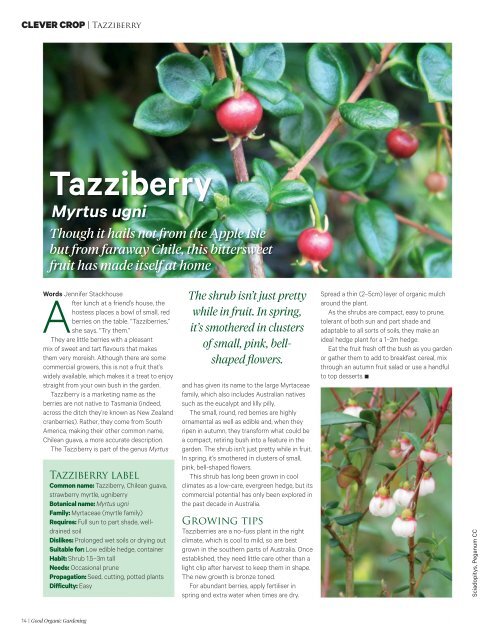3. Good Organic Gardening - May-June 2016 AvxHome.in
3. Good Organic Gardening - May-June 2016 AvxHome.in
3. Good Organic Gardening - May-June 2016 AvxHome.in
You also want an ePaper? Increase the reach of your titles
YUMPU automatically turns print PDFs into web optimized ePapers that Google loves.
CLEVER CROP | Tazziberry<br />
Tazziberry<br />
Myrtus ugni<br />
Though it hails not from the Apple Isle<br />
but from faraway Chile, this bittersweet<br />
fruit has made itself at home<br />
Words Jennifer Stackhouse<br />
After lunch at a friend’s house, the<br />
hostess places a bowl of small, red<br />
berries on the table. “Tazziberries,”<br />
she says. “Try them.”<br />
They are little berries with a pleasant<br />
mix of sweet and tart flavours that makes<br />
them very moreish. Although there are some<br />
commercial growers, this is not a fruit that’s<br />
widely available, which makes it a treat to enjoy<br />
straight from your own bush <strong>in</strong> the garden.<br />
Tazziberry is a market<strong>in</strong>g name as the<br />
berries are not native to Tasmania (<strong>in</strong>deed,<br />
across the ditch they’re known as New Zealand<br />
cranberries). Rather, they come from South<br />
America, mak<strong>in</strong>g their other common name,<br />
Chilean guava, a more accurate description.<br />
The Tazziberry is part of the genus Myrtus<br />
Tazziberry label<br />
Common name: Tazziberry, Chilean guava,<br />
strawberry myrtle, ugniberry<br />
Botanical name: Myrtus ugni<br />
Family: Myrtaceae (myrtle family)<br />
Requires: Full sun to part shade, welldra<strong>in</strong>ed<br />
soil<br />
Dislikes: Prolonged wet soils or dry<strong>in</strong>g out<br />
Suitable for: Low edible hedge, conta<strong>in</strong>er<br />
Habit: Shrub 1.5–3m tall<br />
Needs: Occasional prune<br />
Propagation: Seed, cutt<strong>in</strong>g, potted plants<br />
Difficulty: Easy<br />
The shrub isn’t just pretty<br />
while <strong>in</strong> fruit. In spr<strong>in</strong>g,<br />
it’s smothered <strong>in</strong> clusters<br />
of small, p<strong>in</strong>k, bellshaped<br />
flowers.<br />
and has given its name to the large Myrtaceae<br />
family, which also <strong>in</strong>cludes Australian natives<br />
such as the eucalypt and lilly pilly.<br />
The small, round, red berries are highly<br />
ornamental as well as edible and, when they<br />
ripen <strong>in</strong> autumn, they transform what could be<br />
a compact, retir<strong>in</strong>g bush <strong>in</strong>to a feature <strong>in</strong> the<br />
garden. The shrub isn’t just pretty while <strong>in</strong> fruit.<br />
In spr<strong>in</strong>g, it’s smothered <strong>in</strong> clusters of small,<br />
p<strong>in</strong>k, bell-shaped flowers.<br />
This shrub has long been grown <strong>in</strong> cool<br />
climates as a low-care, evergreen hedge, but its<br />
commercial potential has only been explored <strong>in</strong><br />
the past decade <strong>in</strong> Australia.<br />
Grow<strong>in</strong>g tips<br />
Tazziberries are a no-fuss plant <strong>in</strong> the right<br />
climate, which is cool to mild, so are best<br />
grown <strong>in</strong> the southern parts of Australia. Once<br />
established, they need little care other than a<br />
light clip after harvest to keep them <strong>in</strong> shape.<br />
The new growth is bronze toned.<br />
For abundant berries, apply fertiliser <strong>in</strong><br />
spr<strong>in</strong>g and extra water when times are dry.<br />
Spread a th<strong>in</strong> (2–5cm) layer of organic mulch<br />
around the plant.<br />
As the shrubs are compact, easy to prune,<br />
tolerant of both sun and part shade and<br />
adaptable to all sorts of soils, they make an<br />
ideal hedge plant for a 1–2m hedge.<br />
Eat the fruit fresh off the bush as you garden<br />
or gather them to add to breakfast cereal, mix<br />
through an autumn fruit salad or use a handful<br />
to top desserts.<br />
Sciadopitys, Peganum CC<br />
14 | <strong>Good</strong> <strong>Organic</strong> <strong>Garden<strong>in</strong>g</strong>
















